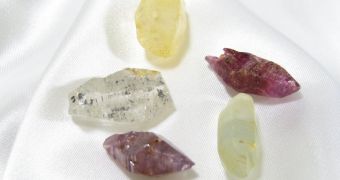Part of the corundum, or aluminum oxide, mineralogical family, sapphires and rubies have always captivated people with their beauty, and the conditions in which these precious stones form still represent a subject of debate. Corundums consist of aluminum oxide crystals doped with impurities that give them various colors, titanium and iron for blue in the sapphire, and chromium and vanadium for the red tints in the ruby.
After diamonds, corundum crystals have the highest hardness, on the Moss scale of mineralogical hardness. The matter of debate, regarding how these stones form, is especially controversial in the case of the sapphires, which are mostly found in alkaline basalts or in volcanic rock, which provides the most commercialized sapphires in the world. Corundums are created at about several tens of kilometers deep inside the crust of the Earth, in extreme pressure and temperature conditions. As the magma in which they form rises to the surface, it also brings up the crystals accumulated during the erosion phase of the surrounding rock.
Usually, they can be found in areas that are associated with sedimentary deposits, thus explaining the difficulty in determining the origin of the corundums inside these secondary deposits.
Results of the attempts to discover the primary genesis of these stones, based on research of the proportion of oxygen isotope trapped inside the crystals, have determined the scientists to create a so-called data bank of the isotopic proportions, for all the deposits of sapphires and rubies in the world. Although there has been a progress in revealing the genesis of these crystals, the study of the primary deposits still represents a crucial aspect in unraveling the mystery related to their provenance.
Recently, a team of researchers, from the University of Antananarivo, Madagascar, has received access to a well preserved shaft that presented ruby rearing rock, brought by magma originating in the mantle. The study of the found mineral showed that they must have formed in pressures close to 20 kbar and in a temperature averaging 1100 degrees Celsius, somewhere 60 kilometers deep inside the mantle.
After comparing the data related to the isotopes ratios in various corundums found in 13 different countries, scientists have been able to conclude that sapphire and rubies, found in alkaline basalts, have their origin in the magma that comes to the surface. This is also confirmed by the fact that, sometimes, these crystals have trapped, inside them, various types of glasses, which can only originate in magmatic environments.
The studies made on 62 different crystal corundum samples, brought from Asia, Australia and Madagascar, revealed that about 20 percent of all the sapphire and ruby crystals originate from basaltic rock, meaning that they must have formed deep under the continental crust, not in the mantle, in the zone between the crust and the Earth's mantle.
Revealing the conditions in which these stones form could help in determining their geological origin, therefore increasing the possibility of finding the mineral and mine the gems. Corundums only provide information about their geological origin, unlike the emeralds that provide both information about the geological origin and the geographic location of the primary deposit, a weird property which could hide the mystery of these beautiful stones for many years to come.

 14 DAY TRIAL //
14 DAY TRIAL //